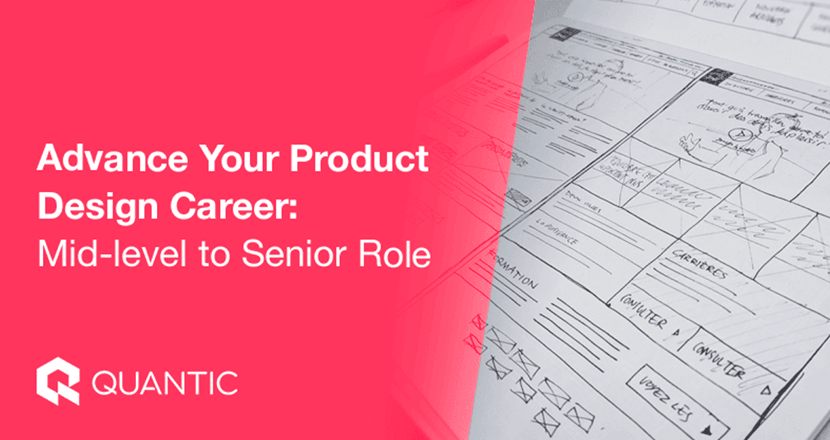CAREER PLANNING
Advance Your Product Design Career: Mid-level to Senior Role
If you’ve risen through the ranks from an entry-level junior designer to a mid-level role, kudos to you. You’ve come a long way in your product designer career advancement. However, as far as career development goes, there’s more room at the top.
Unfortunately, from here on, how your career path progresses depends on skills outside of your product design education.
A senior-level managerial role demands business and people management skills. You will also need financial know-how, administrative acumen, and a host of other business-related skills.
All these skills don’t come included in your training. All the same, this isn’t the end of the road for you; you can still move your career a notch up.
Today we’ll talk about:
- The typical career progression in the product design field
- A plan to propel your career growth
- What you need to do to set the plan in motion
When we’re done, you’ll have a firm grasp on how to put your career path on an upward trajectory. Let’s get right to it.
Product Designer Job Description 2023
In product design, you are responsible for bringing the finished design project to the consumer. The design process often involves putting in long hours to compose, layout, develop and construct the finished product.
The product designer’s role starts by defining the problem. The designers clearly define what the customers want and need. Once they have a straightforward mission, they are now responsible for visualizing and creating a tool that serves the consumer well.
A product design position also entails making improvements to existing product designs. They will also keep tabs on competitors’ product concepts and any similar designs, so competitors don’t outshine the quality and functionality of their products.
With the strides in technology and the internet, the product design role has evolved from previous years.
For starters, the speed at which new products are rolled out has affected the product life cycle. If you don’t want to be buried under your competitors, you constantly have to improve and design better and faster products.
In addition, as a result of internet advancements, modern products are seldom a single entity. Product design now entails not only the design itself but also how to smoothly integrate with other products like AI or voice assistance to improve user experience.
This brings in many variables like:
- How customers will react to the product and ease-of-use with integrated platforms
- How connected devices will affect the products life cycle
- Potential changes in technology that can potentially cause redundancy
- Security against hacking via integrated platforms
- Data security
Plus, design thinking has to be more spontaneous to catch up to fast-moving trends. The user research and prototyping phase of the design process takes less time.
The fast-paced nature of technology changes means product designers need to stay on their toes. Their product designer skills need to stay sharp and fluid to keep up with changes.
On top of that, design projects require more complex analytical skills to consider all the different variables and create products with market appeal and a longer life cycle.
Product Designer vs. UX Designer vs. Management
UX Designer
A UX designer’s role involves understanding the end user’s needs and anticipating the user’s interaction with the system. They do this through in-depth research to understand the user’s pain points and the context within which the user will interact with the product.
Once they set their sights on what the product needs to do, the next step for a UX designer is setting up the product’s main components like the design layouts and user scenarios.
They may also be responsible for redesigning the project at a later stage.
Product Designer
A product designer’s job starts with understanding the user, then proceeds to the design phase of the product. Once they have a suitable design on lockdown, the designer will also be responsible for keeping an eye on how users interact with the product.
They will continue to define, ideate, validate, design, and keep up with developments while collaborating with marketing to push the product in the market.
Product Manager
Product managers pinpoint the customers’ needs and marry these needs with the main business objectives. Once it’s a match, they are responsible for overseeing the ideation, design, and validation process.
They will also have a hand in marketing the final product, monitoring the financials, and watching how the market interacts with the product to implement redesigns if necessary.
| Parameter | Product Design | UX Design | Product Manager |
| Research | ✓ | ✓ | ✓ |
| Planning | ✓ | ✓ | ✓ |
| Design and Development | ✓ | ✓ | ✓ |
| Launch | ✓ | ✓ | ✓ |
| Marketing | ✓ | ✓ for small organizations X for larger companies | ✓ |
| Monitoring | ✓ | ✓ for small organizations X for larger companies | ✓ |
| Financials | X | X | ✓ |
It’s easy to see that these roles have a great deal of overlap. In larger organizations with more personnel, the distinctions may be more noticeable because UX designers work together with product designers up to the product launch.
After the launch, UX designers move on to other products. Product designers nurse the product in its infancy by tweaking and adjusting it. Managers go a step further and oversee the project including the financial aspects.
In smaller organizations, however, there isn’t such a clear-cut distinction. The same design team works together from the research and stays on to launch and watch over the project regardless of job title.
Dwelling on the semantics can limit your skillset. It’s a good idea to enrich your skills rather than defining yourself as a UX designer or strictly product designer. That way, you can function effectively; regardless of how your organization defines your role.
Some companies forego these titles altogether, opting for titles like design strategist, product lead, interface and experience lead, graphic designer, information architect, or interaction designer.
Whichever way you are referred to, the primary role is inherently the same until you reach the management level.
Product Designer Career Ladder
The typical career path for product designers starts with junior-level roles. At this stage, your involvement is usually limited to a contribution and not directly involved in influencing the workflow in a significant way.
When you gain more experience, you can progress to mid-tier roles. You will now have a more prominent involvement and greater responsibilities on the projects you work on.
Then, as you progress, you can be promoted into senior designer and management roles, which give you more oversight of projects. You will take part in launching, marketing, or pulling the plug on loss-making products.
You’re responsible not just for managing people but also for contributing to keeping the business afloat.
To move up the career ladder, you will need to deepen your skillset. While managerial roles don’t usually require hands-on design work, you will still need to be highly skilled at design. Plus, you need an extra layer of skills that covers the business side of things.
Let’s get into more detail about each stage of the career path.
Junior Product Designer
The junior design job is an entry-level role that requires knowledge of design methods and tools. Some of the tasks include:
- Creating wireframes
- Developing detailed visual designs
- Making interactive prototypes and UX flows
- Support and collaborate with the senior designers to bring the final product.
Mid-level Product Designer
Mid-level designers are responsible for brainstorming and executing product development. They’ll take on tasks like:
- Planning, making designs, and modeling products
- Creating and testing prototypes
- Analyzing competitors’ working concepts
- Bringing the final product to market
- Keeping tabs on development and latest design trends
Senior Product Designer
Senior roles involve more oversight and responsibility. The main functions include:
- Outlining project goals, including collaborating with the client and other designers to clarify product vision
- Creating project budgets and forecasts
- Negotiating time-frames
- Overseeing product development and user testing
- Working with sales and marketing
- Staying aware of product performance
Product Designer’s Salary
Designers earn different salaries depending on the stage of their career progression. Here’s a breakdown of the salary at each level.
Junior Product Designer Salary
According to Zip Recruiter, junior product designers earn an average of $64,144 per year, which translates to $31 an hour.
Mid-level Product Designer Salary
Mid-level designers make a median salary of $71,120 per annum, according to Zip Recruiter statistics.
Senior Product Designer Salary
Zip Recruiter says, on average, senior-level product designers earn an annual salary of $117,598.
Product Design Advance Your Career Plan
Interested in climbing your way up the ladder? Here’s the plan: gain new business-related skills to become eligible for senior roles.
With a new set of skills, you can handle the tasks that come with senior roles.
Understanding the business side will help you develop products that provide a great user experience and rake in profits.
As a product manager, Lindsey Allard had to know a little about a lot of things, and the Quantic MBA program helped her to gain a broad range of business knowledge. This, in turn, helped her to co-found PlaybookUX, a video-based user feedback solution for B2B companies. PlaybookUX’s success is largely due to the company’s ability to solve pain points related to user research, such as being time-consuming and expensive. PlaybookUX uses AI to extract actionable insights, which saves time and money for businesses that want to conduct user research.
Here are some of the primary skills you need to thrive in senior-level roles. Maybe you can even follow in Lidsey’s footsteps and start your own company.
Leadership Skills
Developing and launching a product involves many people. Once the product is launched, it will involve even more people to market and move the product to help it rise above the competition.
It takes a strong leader to plan and coordinate the different personnel involved in any project.
Without solid leadership skills, you can crumble under the pressure of managing different personalities. Plus, once you get the hang of the right techniques, you won’t fall into the trap of micro-managing.
Communicating Effectively
If you don’t have concrete communication skills, it’s not easy to rally people toward a vision. Knowing what, when, and how to convey information makes the difference between excellent management and those who just get by.
When you learn effective communication, you can clearly articulate the vision behind a design project. You can talk to people at various levels in the organization through proposals, charts, memos.
On top of that, you can collaborate with peers and subordinates for the business to stay on track.
In addition, these skills can help you thrive as a manager by:
- Consolidating a warm culture in your organization
- Improving employee engagement
- Lowering fatigue and burnout in your team
Staying Flexible
The world of design and business is fast-paced. That’s why flexibility is key to moving up in the product design chain of command.
If you’re flexible, you keep your eye on the price. Setbacks and challenges don’t phase you; instead, you adjust accordingly. This includes both when designing products and handling business affairs.
Business and Financial Management
No matter how good a product is, if it doesn’t make a good profit or at least break even, it makes no business sense to keep it.
If you wait until the product launch to crunch the numbers, you won’t succeed in business. You will need to start every product ideation with:
- Forecasts
- Financial models that predict the product’s profitability
- Budgets
Once the development is underway, you have to track and monitor spending within the budget. Plus, find ways to reduce costs.
With all the calculations you have to run through, it’s easy to see why financial skills are critical for top-level positions.
Priority Problem Solving
Problem-solving skills come easy to you. You can focus for hours on a design system, and you won’t come up for air until it meets user expectations.
However, management roles require a different kind of focus. You will need to solve a series of complex problems simultaneously. This kind of multi-tasking calls for priority problem-solving skills.
You will need to organize your tasks and tackle them in order of priority without the option of skipping anything. With priority problem-solving skills, you can figure out how to allocate time effectively to each task and ensure overall success.
MBA Course Curriculum for Product Designers
Here’s the next step of the plan— take action to acquire all the skills you need to move up.
You can read up on each skill set and maybe scour the internet for hours on end to find as much information as you can.
Alternatively, take up a good MBA course like Quantic’s MBA program.
With a Quantic MBA program, you’ll learn all the skills you need to progress quickly and effectively through advanced pedagogical methods. Plus, it comes at an affordable cost allowing you to scale greater heights in your career minus the huge loan burden.
A good MBA course will walk you through the following:
- Business. When advancing your product design career, you need to get a handle on the business side, including finance, projections, statistical probabilities, and marketing.
- Strategy. In a senior role, you will need to develop strategy and effective plans that help the business stand head and shoulders above competitors.
- Decision Making. Business is all about critical decision-making. You will need to know how to choose the best outcome using all the data in front of you.
- Leadership. Overseeing a design team takes exceptional leadership skills.
Product Design MBA?
We’ve established that an MBA can help you with your career development, but why a Quantic MBA over a product design-specific MBA?
You’ll learn more or less the same skills with both programs. So, it all comes down to what else you can get from the program besides skills.
Unique Teaching Style
Forget boring lectures and tonnes of study material. Quantic MBA is fully interactive and collaboration-based. That way, you’ll stay fully immersed throughout the course.
Flexibility
Quantic’s MBA program is flexible. You can pick up your lessons at any time that suits your demanding work schedule. There are no strict timetables or lesson times.
Apply to Quantic MBA now to take your career to the next level.
Summary
Product designer career paths start from junior-level roles then progress to mid-level responsibilities, which involve hands-on product development.
The next step in career progression is the senior designer and management roles that involve more supervision and higher pay.
You will need a unique set of business skills to move up the ladder. The fastest and most cost-effective way to progress is through a well-structured comprehensive MBA program like Quantic’s MBA.



